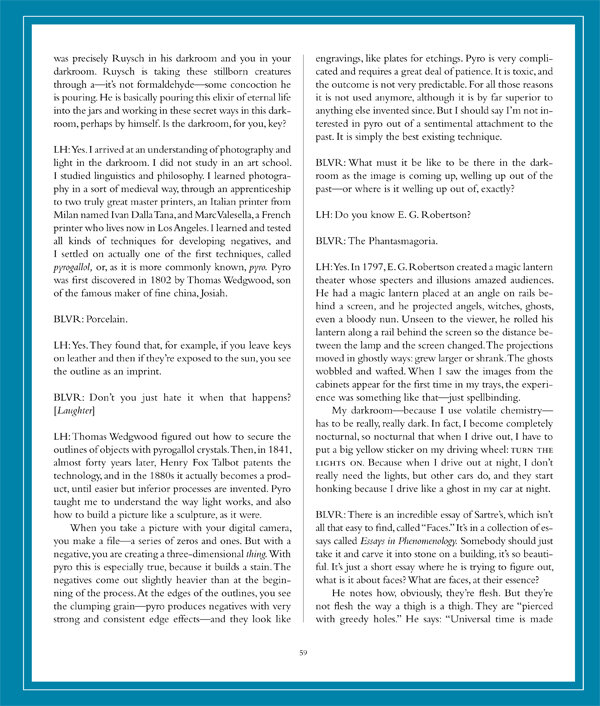ESSAYS
LENA HERZOG INTERVIEWED BY LAWRENCE WESCHLER
Things coming to Europe from America, circa 1500:
Purple parrot feathers
Moose antlers
Sacrificial urns
Tropical butterflies
Dinosaur bones considered to be the bones of giants
Back in 1594, in the very heart of the period we will be considering in the pages that follow, Sir Francis Bacon, while prescribing the essential apparatus for “a compleat and consummate Gentleman” in his Gesta Grayorum, suggested that in attempting to achieve “within a small compass a model of the universal made private,” any such would-be magus would almost certainly want to compile “a goodly huge Cabinet, wherein whatsoever the Hand of Man by exquisite Art or Engine, hath made rare in Stuff, Form, or Motion, whatsoever Singularity, Chance and the shuffle of things hath produced, whatsoever Nature hath wrought in things that want Life, and may be kept, shall be sorted and included.”
Things that want life and may be kept, indeed. Just over a hundred years later, the young Russian who would go on to become Peter the Great, then age fifteen and summering in Amsterdam, happened into the chambers of the legendary dissector and anatomist Frederik Ruysch and first fell under the thrall of the good doctor’s uncanny collection of bottled fetuses; years later, he would buy the entire collection, bringing them back to the capital he was then constructing for himself, St. Petersburg, as the core of the vast wonder cabinet that he himself had begun compiling.
Was it just chance, though, and the shuffle of things, that, almost three centuries after that, brought our protagonist, the then-seventeen-year-old Russian philology student Lena Pisetski, here, stumbling into the dusty precincts of the old czar’s largely abandoned cabinet? Whatever the reason, the astonishing marvels she visioned that silver late afternoon stayed with her. And years later, a now-accomplished documentary and fine-art photographer (in the meantime married to the German filmmaker Werner Herzog), she returned to prize them anew: both those in St. Petersburg, and other similarly flecked wonders in Vienna, Amsterdam, Leiden, Utrecht, London, Berlin, Paris, Turin, Pavia, and even Philadelphia (the incomparable Mütter!).
The resultant body of work—achingly limpid, hauntingly suspended—was recently brought together in a book, Lost Souls, and exhibited, to widespread critical acclaim, at the International Center of Photography in New York, a show that in turn proved the occasion for a conversation between Ms. Herzog and myself as part of the New York Public Library LIVE series, parts of which are adapted in what follows.
Lawrence Weschler
THE BELIEVER: Could you walk us through who Ruysch was, and what on earth his jugged fetuses were doing in St. Petersburg?
LENA HERZOG: He was born in The Hague in 1638 to a family of very, very modest means. He lived to be almost a hundred. He died at the age of ninety-two. Despite his background, he became a prominent scholar: a botanist, an anatomist, and was even called to be a forensic adviser to the Amsterdam court. When asked why did he switch to anatomy, he said something very interesting. He said botany’s questions were too simple and so were the answers. It is in anatomy where all the riddles lie.










